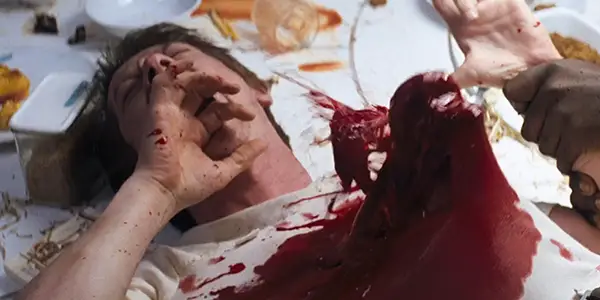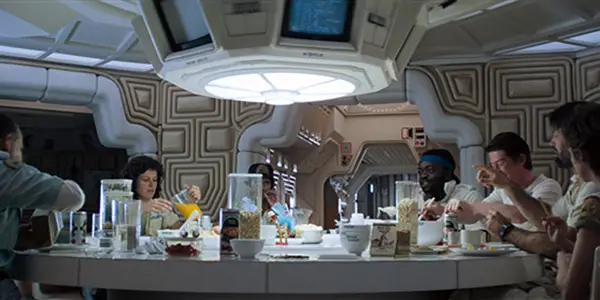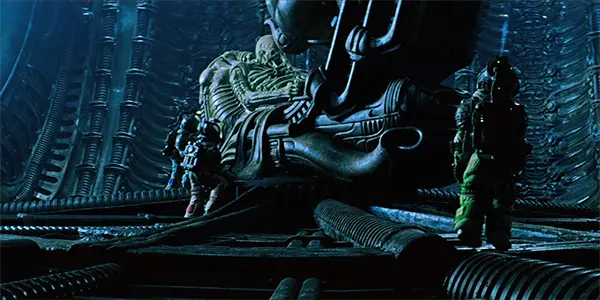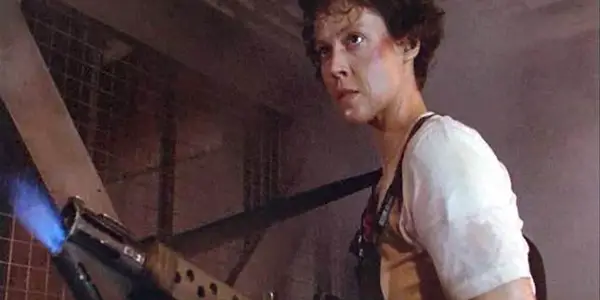ALIEN: 40 Years Of Xenomorphs & The Legacy Of Ellen Ripley

David is a film aficionado from Colchester, Connecticut. He enjoys…
Alien is one of those movies that would never be made today. It’s quiet, introspective, dark, and actually quite uneventful for much of its first half, before things start to go off-the-wall towards the end. Just look at how modern interpretations have tried and failed, including the somewhat interesting yet ultimately too heavy Prometheus and its sequel Alien: Covenant, a film loaded with CGI monsters and philosophical overtones that were merely hinted at in the original movies. Somehow also directed by Ridley Scott, they attempt to unnecessarily insert backstory for the original Alien.
Yet, Alien and its sequel Aliens were never overly concerned at providing an explanation for the xenomorph creatures. And frankly, they don’t need an explanation. The aliens have often been seen as overtly sexual creatures, considering their method of implanting an embryo into a human body, only to burst out once grown large enough. Who can forget that first image of Kane as he writhes on the table and his chest opens up? Even 40 years later, it shocks and horrifies on a visceral level, and not just because of all the blood.

With my latest rewatch of both Alien and Aliens, I will attempt to get at just what endures about these movies after all these years (I won’t be discussing Alien 3 or Resurrection, movies which I prefer to believe don’t exist). What better time to do it than now, as the original movie was released 40 years ago as of 2019. So strap in, and lets revisit LV-426 just once more. I’m sure it won’t end badly this time.
The Crew of the Nostromo
First, we’ll start at the quintessential pieces of any movie, science fiction or otherwise: the characters. Alien is populated by the crew of the Nostromo. They are Dallas (Tom Skerritt), the captain of the ship; Lambert (Veronica Cartwright), the navigator; Brett (Harry Dean Stanton) and Parker (Yaphet Kotto), the ship’s engineers; Kane (John Hurt), the executive officer; Ash (Ian Holm), the science officer; and, saving the best for last: Ellen Ripley (Sigourney Weaver), the warrant officer.
The story is likely one you already know, and in many ways because of this movie, as it gave birth (no pun intended) to the trapped survival movie, in which a group of people are in an isolated location and a common threat takes them out one by one. The story, in case you need a refresher, is as follows: the service crew of the Nostromo, on their way back to Earth, are intercepted by a signal on an isolated moon, and while there encounter an alien ship. Within its depths are mysterious egg-like substances, and one member of the crew, Kane, is attacked by an organic lifeform, which attaches itself to his face. Later, it falls off, but little does Kane know what is about to happen: an alien creature bursts from his chest, and soon starts to pick off the crew of the Nostromo one by one.

What I really noticed after this rewatch is how each of the crew of the Nostromo is afflicted by, and ultimately dies from, one definitive flaw in particular. Discussing in the order that they are killed, first we have Kane, who was too curious, leading him to be infected by the facehugger and ultimately killed by the alien. Brett is too timid, and the alien easily takes him. Ash, the ship’s android who orchestrated the entire series of events, is far too obedient, since it was the executive order to bring back the lifeform that he was blindly attached to, despite the potential loss of life.
Dallas, the ship’s captain, is too sympathetic. He not only decides to let the infected Kane aboard the ship, disregarding quarantine procedures, but he then goes on a solo trip to try to force the alien out of an airlock, which leads to his death. That leaves Parker, who is overconfident in his ability to kill the creature, and Lambert, who is frozen by fear. The two are easily overpowered.
Significantly, the only one left standing in the end is Ripley. She possesses each of the above traits to some extent, as she is imperfect, but what she doesn’t have is one trait that overtakes all others. She is sympathetic, but not overly so, as can be seen when she argues that Kane should not be brought on board the ship if he was infected with something since that puts everyone else at risk. She’s obedient to orders, but never would have blindly followed them like Ash did. She’s not overconfident, and chooses to run or hide when she needs to from the alien rather than taking it on. And she doesn’t surrender to fear either, as we see in the film’s closing moments when she takes on the creature and shoots it out of the airlock, upon realizing that she has no other choice.
Really, between this movie and Aliens, one thing is clear: everyone should have just listened to Ripley all along. If they had, Alien would’ve been over at the halfway mark. And Aliens would’ve ended with much more than just three people standing. But what fun would that be?
Production Design and the Creature
Witnessing the world-building of Alien once again, it’s hard not to be completely enamored by the film’s production design and special effects. The alien effects were created by Swiss artist H.R. Giger, while the more human aspects were created by Ron Cobb and Chris Foss. Working in tandem, the three emphasize the stark difference between the human and alien spaceships.

As the Nostromo crew investigates the alien ship, what really sticks out is the bone-like structure of it. Snaking along the walls and ceiling, the ribs curve in seemingly unnatural ways, and become unsettling in the ways that they defy conventional forms. The world aroud it is just as eerie, with mist overlaying the ground, and later on a giant human-like creature sitting in a chair, with its chest burst outward, foreshadowing what is to come. (This small moment also, unfortunately, led to the Prometheus backstory).
Later, we see the giant eggs jutting out of the floor, waiting for a human host. The facehuggers are spidery, but oddly sexual as well, resembling female genitalia, making for an uncomfortable combination. While the actual aliens, the xenomorphs, which have since become iconic in the world of science fiction monsters, are quite unsettling in their own way. Tall yet human-like, they have four limbs, tentacles, a bulbous head, and a double jaw, one of which can come out and jab its prey.

What really works about the initial xenomorph design is that the effects for it, unlike how it would be in later films after Aliens, are all practical. When we first see the xenomorph all grown up, with his dripping mucus, snarling teeth, and gigantic, towering frame, he’s terrifying to us because he looks so real. The creature is played in the film by Bolaji Badejo, who was chosen by Ridley Scott due to his 7’2 stature, and with enough makeup and prostethetics on, you can’t even tell that it’s a person in a costume. The creature is also rarely seen for more than a few seconds at a time, adding to its air of mystery.
Compare this to the clearly CGI drawn alien that jumps onto the ship in Alien: Covenant. Here, the creature, who is unforuntately shown in the bright light of day, is clearly a computer creation. It doesn’t have nearly the same effect, either by being digital or the way it is shown out in the open. Sometimes, you really can’t beat the old school ways of filmmaking.
The Legacy of Ellen Ripley
Just as much as the special effects and creature design, it’s Ellen Ripley who also makes these movies. (Once again just talking about Alien and Aliens. Still waiting for that obligatory Alien sequel that ignores the other sequels, similar to what they did for both Halloween and Terminator). At any rate, it’s Ellen Ripley, and Sigourney Weaver’s performance over these two movies, that really brings them to another level.

As mentioned earlier, Ripley is always the most level-headed member of any group. Though underestimated and often ignored due to her gender, she always has her head in the right place. She looks out for people, can anticipate disaster, and is equipped with or ready to learn the know-how in any given situation. It also helps that she’s a bonified badass. The last few minutes of Aliens is really all you need to glance at to know this. Loaded up with weaponry, she single-handedly reenters the swarming alien nest in order to rescue the captured Newt, who she had promised would be safe. The standoff between Ripley and the alien queen, both here and in the scene that would follow (“Get away from her, you bitch!”), are the stuff of legends.
Ripley stands out as a sci-fi heroine because, as mentioned earlier, she isn’t flawless. At the start of Aliens, she is having nightmares and is suffering from PTSD as a result of the events of Alien, allowing Weaver to show her character’s vulnerability. Later, she willingly goes back to the place that had given her those nightmares, in order to face her demons head-on. Ripley isn’t a hero because she always wins; she’s a hero because, no matter how many setbacks she has, she refuses to give up. That’s an example that we should all aspire to.
The Alien Legacy
Both Alien and Aliens are classic science fiction films in their own right. Where Alien is a small, contained film, Aliens opens up its world, populates it with developed, quirky characters, and ups the ante on the action and the creatures themselves, becoming more of a war film than previously. Ridley Scott created this iconic world, and James Cameron took it and ran with it, creating a film that equals it, albeit in very different ways.
Where the franchise went from here, though, is what will always bum me out. Seeing the success of these two films, the studio jumped in deeper, deciding to branch out into two more Alien movies with Ripley, followed by the very unfortunate crossover films Alien vs. Predator, and then, as stated earlier, the misconstrued Prometheus and Alien: Covenant. With Covenant not being much of a success, though, the future of this franchise seems uncertain. Regardless, it’s true that almost every major series wears out its welcome eventually, and rare that something comes along that gives it new life.
I’m still holding out at least some hope, though, that maybe someone can come along and revitalize the Alien series. Sigourney Weaver, who has expressed interest in returning, can bring Ripley back and give us the Alien 3 we’ve always wanted. Until then, I’ve always got Alien and Aliens, two of the greatest sci-fi movies ever made. Ones which myself, and the sci-fi community as a whole, will never tire of.
What are your thoughts on Alien and Aliens? Are you a fan of the series? Let us know in the comments below!
Does content like this matter to you?
Become a Member and support film journalism. Unlock access to all of Film Inquiry`s great articles. Join a community of like-minded readers who are passionate about cinema - get access to our private members Network, give back to independent filmmakers, and more.
David is a film aficionado from Colchester, Connecticut. He enjoys writing, reading, analyzing, and of course, watching movies. His favorite genres are westerns, crime dramas, horror, and sci-fis. He also enjoys binge-watching TV shows on Netflix.












